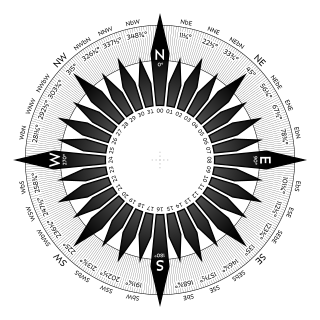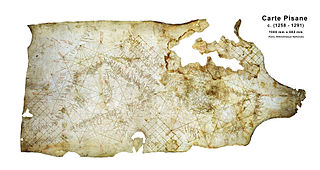Related Research Articles

A nautical chart or hydrographic chart is a graphic representation of a sea region or water body and adjacent coasts or banks. Depending on the scale of the chart, it may show depths of water (bathymetry) and heights of land (topography), natural features of the seabed, details of the coastline, navigational hazards, locations of natural and human-made aids to navigation, information on tides and currents, local details of the Earth's magnetic field, and human-made structures such as harbours, buildings, and bridges. Nautical charts are essential tools for marine navigation; many countries require vessels, especially commercial ships, to carry them. Nautical charting may take the form of charts printed on paper or computerized electronic navigational charts. Recent technologies have made available paper charts which are printed "on demand" with cartographic data that has been downloaded to the commercial printing company as recently as the night before printing. With each daily download, critical data such as Local Notices to Mariners are added to the on-demand chart files so that these charts are up to date at the time of printing.

A compass rose, sometimes called a wind rose, rose of the winds or compass star, is a figure on a compass, map, nautical chart, or monument used to display the orientation of the cardinal directions and their intermediate points. It is also the term for the graduated markings found on the traditional magnetic compass. Today, a form of compass rose is found on, or featured in, almost all navigation systems, including nautical charts, non-directional beacons (NDB), VHF omnidirectional range (VOR) systems, global-positioning systems (GPS), and similar equipment.

The points of the compass are a set of horizontal, radially arrayed compass directions used in navigation and cartography. A compass rose is primarily composed of four cardinal directions—north, east, south, and west—each separated by 90 degrees, and secondarily divided by four ordinal (intercardinal) directions—northeast, southeast, southwest, and northwest—each located halfway between two cardinal directions. Some disciplines such as meteorology and navigation further divide the compass with additional azimuths. Within European tradition, a fully defined compass has 32 "points".
Piloting or pilotage is the process of navigating on water or in the air using fixed points of reference on the sea or on land, usually with reference to a nautical chart or aeronautical chart to obtain a fix of the position of the vessel or aircraft with respect to a desired course or location. Horizontal fixes of position from known reference points may be obtained by sight or by radar. Vertical position may be obtained by depth sounder to determine depth of the water body below a vessel or by altimeter to determine an aircraft's altitude, from which its distance above the ground can be deduced. Piloting a vessel is usually practiced close to shore or on inland waterways. Pilotage of an aircraft is practiced under visual meteorological conditions for flight.

Jan Huygen van Linschoten was a Dutch merchant, traveller and writer.

Portolan charts are nautical charts, first made in the 13th century in the Mediterranean basin and later expanded to include other regions. The word portolan comes from the Italian portolano, meaning "related to ports or harbors", and which since at least the 17th century designates "a collection of sailing directions".

Sailing Directions are written directions that describe the routes to be taken by boats and ships during coastal navigation and port approaches. There are also products known as Sailing Directions, which are books written by various Hydrographic Offices throughout the world. They are known as Pilot Books, because they provide local knowledge of routes and landmarks, which would typically be provided by a local marine pilot. As such, they are used frequently by naval and government vessels, who are exempted from 'Compulsory Pilotage' in many ports.

The history of navigation, or the history of seafaring, is the art of directing vessels upon the open sea through the establishment of its position and course by means of traditional practice, geometry, astronomy, or special instruments. Many peoples have excelled as seafarers, prominent among them the Austronesians, the Harappans, the Phoenicians, the Iranians, the ancient Greeks, the Romans, the Arabs, the ancient Indians, the Norse, the Chinese, the Venetians, the Genoese, the Hanseatic Germans, the Portuguese, the Spanish, the English, the French, the Dutch, and the Danes.

"Majorcan cartographic school" is the term coined by historians to refer to the collection of predominantly Jewish cartographers, cosmographers and navigational instrument-makers and some Christian associates that flourished in Majorca in the 13th, 14th and 15th centuries until the expulsion of the Jews. The label is usually inclusive of those who worked in Catalonia. The Majorcan school is frequently contrasted with the contemporary Italian cartography school.

The Carta Pisana or Carte Pisane is a map probably made at the end of the 13th century, about 1275–1300, currently conserved in the Département des cartes et plans at the Bibliothèque nationale de France. New research suggests that it was made a century later. It was found in Pisa, hence its name. It shows the whole Mediterranean, the Black Sea and a part of the Atlantic coast, from the north of present-day Morocco to the present-day Netherlands, but the accuracy of the map is mostly limited to the Mediterranean. It is the oldest surviving nautical chart. It is a portolan chart, showing a detailed survey of the coasts, and many ports, but bears no indication on the topography or toponymy of the inland. On the map, North is on the top, in contrast to other maps of the same period such as the Hereford Mappa Mundi, where East is on the top.

Giovanni da Carignano, or Johannes de Mauro de Carignano, was a priest and a pioneering cartographer from Genoa.
Domenico and Francesco Pizzigano, known as the Pizzigani brothers, were 14th-century Venetian cartographers. Their surname is sometimes given as Pizigano in older sources.
The Tammar Luxoro Atlas, or Atlante Luxoro, is an anonymous collection of Italian portolan charts from the early 15th century, currently held at the Biblioteca Civica Berio in Genoa, Italy. The author is unknown, although believed to have been made by Francesco de Cesanis of Venice.

The Cornaro Atlas is an extensive Venetian collection of nautical charts and tracts, currently held in the Egerton Collection of manuscripts of the British Library.

The rule of marteloio is a medieval technique of navigational computation that uses compass direction, distance and a simple trigonometric table known as the toleta de marteloio. The rule told mariners how to plot the traverse between two different navigation courses by means of resolving triangles with the help of the Toleta and basic arithmetic.

Roteiro is the name given to a handbook for the use of maritime pilots and sailors. The Portuguese term is cognate and approximate synonym of the English rutter. Roteiro is applied generally to maritime literature in use from the 16th to the 19th centuries, and specifically to nautical route descriptions compiled by and for sailors and pilots.

A rhumbline network is a navigational aid consisting in multiple lines in a web-like grid drawn on portolan charts. These nautical charts were used in the medieval age and age of exploration in marine navigation.

The School of Sagres, also called Court of Sagres is supposed to have been a group of figures associated with fifteenth century Portuguese navigation, gathered by prince Henry of Portugal in Sagres near Cape St. Vincent, the southwestern end of the Iberian Peninsula, in the Algarve.
David Watkin Waters was a British naval officer, historian of navigation, and naval historian, who served as deputy director of the National Maritime Museum, Greenwich, 1971–1978.
The Hydrographic Institute of the Republic of Croatia is a government agency responsible for providing hydrographic and marine geospatial data for the Republic of Croatia. The institute is located in Split, and covers scientific research and development, services related to the safety of navigation, the hydrographic-geodetic survey of the Adriatic sea, marine geodesy, design and publication of nautical charts and books, oceanographic research, and submarine geology research. The Croatian Hydrographic Institute is responsible for the development of navigational safety service in the Adriatic, within the worldwide navigational safety system, and in cooperation with the Ministry of the Sea, Transport and Infrastructure, port authorities, the Croatian Navy, lighthouse authorities, and hydrographic offices of all maritime countries, following internationally agreed standards.
References
- ↑ Kemp, Peter, ed. (1993). The Oxford Companion to Ships and the Sea. Oxford, United Kingdom: Oxford University Press. p. 242. ISBN 0192820842.
- ↑ Taylor, (1956: p. 103); Parry (1963: p. 85).
- ↑ Aczel (2001)
- ↑ Brown (1949: p. 103), Taylor (1956: pp. 111–12). See also Lanman (1987) and Campbell (1987, 2011)
- ↑ Edson (2007: 51)
- ↑ Waters (1985: p. 241); also Markham (1880: p. 355). The first English edition (1528) of Garcie was entitled The Rutter of the Sea, with the laws of the yle of Auleron and translated by Robert Copeland. Copies of the third edition (1541) contained "A rutter of the northe, compyled by Rychard Proude".
- ↑ "Prominent Istrians: Pietro Coppo". Istria on the Internet. Istrian American Charities Association, Inc. Archived from the original on November 26, 2014.
- ↑ Channing, Edward; et al., eds. (1886). Narrative and Critical History of America ...: Spanish explorations and settlements in America from the fifteenth to the seventeenth century. Houghton, Mifflin and co. p. 128.
- ↑ Koeman (1985), Schmidt (2001: p. 153)
- ↑ "Book of the position of the coasts and the form of our sea, the Mediterranean". Uncovered in Patrick Gautier Dalché (1995) Carte marine et portulan au XIIe siècle. Le Liber de existencia rivieriarum et forma maris nostri Mediterranei, Pise, circa 1200 Paris: Boccard.
- ↑ Motzo, B.R. (1947) Il compasso da navigare: opera italiana della metà del secolo XIII. Pref. e testo del Codice Hamilton 396, Annali della Facoltà di Lettere e Filosofia della Università di Cagliari, pp. 1–137.
- ↑ Breusing, A. (1876) Das Seebuch von Karl Koppmann. Bremen: Kühtmann. online
- ↑ Esmeraldo de Situ Orbis, 1892 edition, Lisbon: Imprensa Nacional.online
- ↑ Matthew Boyd Goldie, 'An Early English Rutter: The Sea and Spatial Hermeneutics in the Fourteenth and Fifteenth Centuries', Speculum, 90 (2015), doi : 10.1017/S0038713415001396
- ↑ Livro de Marinharia: tratado da agulha de marear. Roteiros, sondas, e outros conhecimentos relativos á navegação, first pub. 1903, Lisbon: Libanio da Silva. online
- ↑ Originally published separately in 1595, the rutter Reysgheschrift was reprinted in 1596 as the second part of Linschoten's Itinerario (1596). In the 1598 English translation, the rutter was inserted as the Third Book.